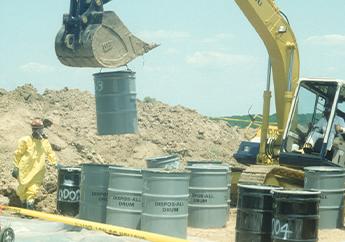
Cleaning up Superfund sites is a complex, multi-phase process. After a site has gone through initial assessment and investigation and the department determines cleanup is needed, the department and U.S. Environmental Protection Agency's (EPA) work together to begin negotiations for site cleanup. "Removal" actions are immediate, short-term cleanup responses intended to protect nearby residents and workers, or the environment, from threats posed by the hazardous substances. "Remedial" actions tend to be long-term cleanup actions, which often include more extensive and costly measures. If the site qualifies for the National Priorities List (NPL), EPA and the department will oversee the cleanup actions. For more information about specific Missouri sites undergoing cleanup, visit Superfund Sites.
One of the first actions the department and EPA take is to identify the parties responsible for contaminating the site. Since the sites may have been abandoned, or the contamination occurred a long time ago, it is often difficult to locate the potentially responsible party (PRP). If there are no PRPs, federal Superfund dollars pay for the cleanup work. For sites on the NPL, the state must contribute 10 percent of the cleanup costs.
If the PRP can be located, they are required to conduct and pay for the investigation and cleanup. Either the department or EPA will provide oversight alone or both will provide oversight together, with one acting as the lead agency. The PRP can choose to enter the department's State Superfund Cooperative Program and clean up the site under state authority, with the department providing oversight. If the PRP chooses not to enter into the Cooperative Program, the site is referred to EPA and the clean up is addressed under EPA Superfund enforcement.
Remedial Investigation/ Feasibility Study
This stage involves evaluating the type and amount of waste released (nature of the contamination) and where the waste is located (extent of contamination) at a site and assessing potential threats to human health and the environment. This stage of the process also includes evaluating the potential performance and cost of the treatment options identified for cleanup of the site.
Proposed Plan and Record of Decision
The department and EPA work together to select the best cleanup method, or remedial action, for each site. The remedial action is detailed in the proposed plan for each site. One of the goals of Superfund is to make sure site cleanup is consistent with the likely future use of a site. Many factors are taken into consideration, including the potential for human exposure based on the anticipated land use, the available technology and cost.
The community also has input on the remedial action chosen. The department and EPA invite the public to review and comment on the proposed plan before the department and EPA make a final decision. After the public comment period ends, the department and EPA write a record of decision that describes the final remedial actions selected, taking into account the studies, public comments and community concerns.
For more information about how you can become involved in the Superfund cleanup process, visit EPA's Superfund Community Involvement webpage. Public notices issued for currently open public comment periods and scheduled public meetings, public hearings and other public events can be found on the following webpages:
Remedial Design/ Remedial Action
During this stage, detailed cleanup plans are developed and carried out. The remedial design phase covers pre-construction investigation and planning activities in preparation for remedial action at the site. Remedial design includes developing engineering drawings and specifications for the site cleanup. There are a number of approaches for remedial design, but they generally follow similar phased patterns. Monitoring and safety planning are essential components of remedial design that evolve as the project moves into remedial action.
- Design monitoring starts with documenting baseline site conditions, so when field activities begin, any changes that occur can be recognized and appropriate actions taken. The monitoring plan is expected to become more complex as fieldwork is developed and remedial action begins.
- Design safety planning includes documents designed to keep workers safe in the field, and are typically referred to as health and safety plans. Additional safety planning is developed to protect site personnel and the public during potential emergency events.
- The remedial design work plan and design criteria report describe in detail how the design phase will be implemented to ensure the remedial action complies with the record of decision and protects human health and the environment. These documents also describe where information will be presented leading up to the final design.
Remedial action follows design, and involves the actual construction or implementation phase of site cleanup.
Operations and Monitoring
Some sites with contaminated groundwater may take many years to clean up and require long-term operation and monitoring of a groundwater treatment system. Groundwater samples are taken periodically and site conditions are monitored to ensure the cleanup was effective in controlling exposure risk at the site. Some sites may also have waste left behind that could not be completely removed. These long-term stewardship sites require monitoring to make site conditions remain safe.
For more information about the Superfund cleanup process, visit EPA’s Superfund Cleanup Process webpage. You may also visit EPA's How Superfund Addresses Groundwater Contamination.
